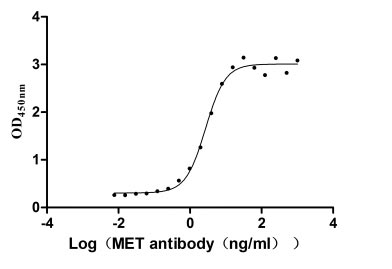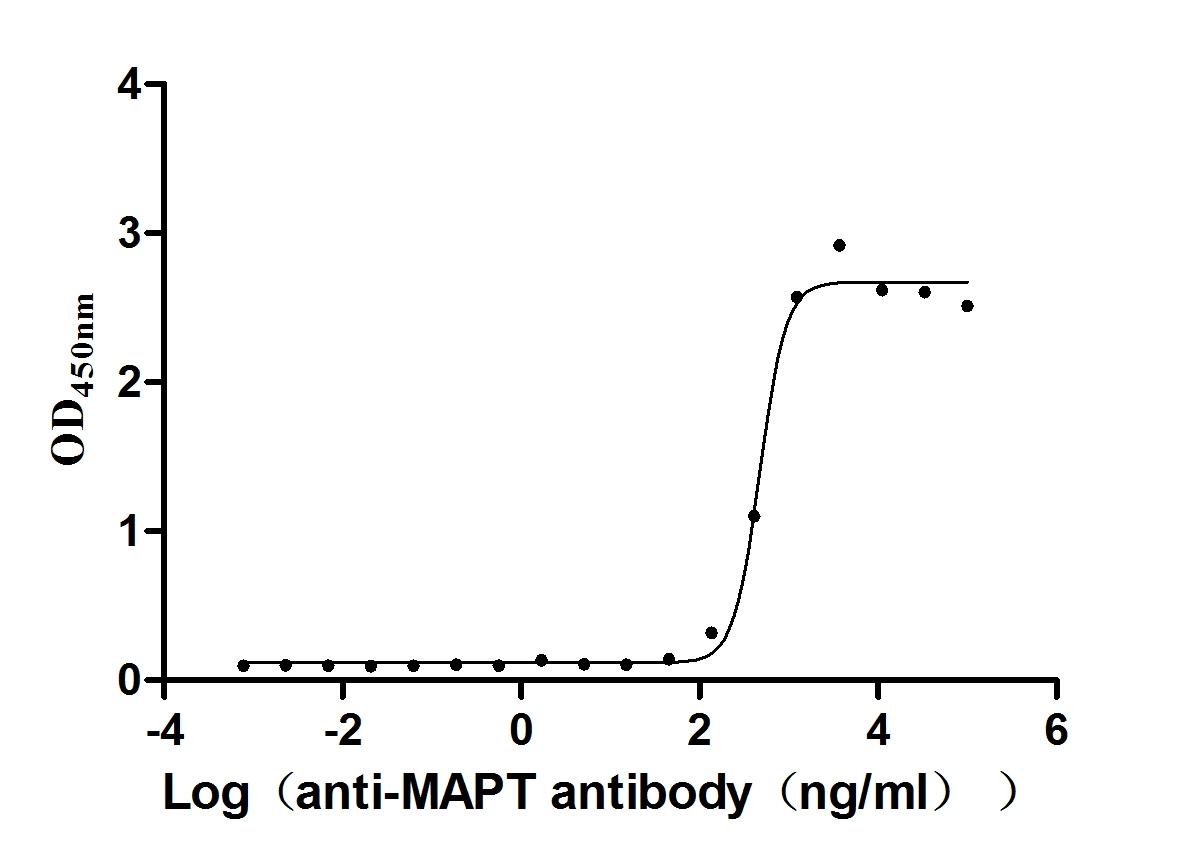Recombinant Human Interleukin-26 (IL26)
In Stock-
货号:CSB-YP873613HU
-
规格:¥1500
-
图片:
-
其他:
产品详情
-
纯度:Greater than 90% as determined by SDS-PAGE.
-
基因名:IL26
-
Uniprot No.:
-
别名:AK155; IL 26; IL-26; IL26; IL26_HUMAN; Interleukin 26; Interleukin-26; Protein AK155
-
种属:Homo sapiens (Human)
-
蛋白长度:Full Length of Mature Protein
-
来源:Yeast
-
分子量:19.6kDa
-
表达区域:22-171aa
-
氨基酸序列KHKQSSFTKSCYPRGTLSQAVDALYIKAAWLKATIPEDRIKNIRLLKKKTKKQFMKNCQFQEQLLSFFMEDVFGQLQLQGCKKIRFVEDFHSLRQKLSHCISCASSAREMKSITRMKRIFYRIGNKGIYKAISELDILLSWIKKLLESSQ
Note: The complete sequence including tag sequence, target protein sequence and linker sequence could be provided upon request. -
蛋白标签:N-terminal 6xHis-tagged
-
产品提供形式:Liquid or Lyophilized powder
Note: We will preferentially ship the format that we have in stock, however, if you have any special requirement for the format, please remark your requirement when placing the order, we will prepare according to your demand. -
缓冲液:Tris-based buffer,50% glycerol
-
储存条件:Store at -20°C/-80°C upon receipt, aliquoting is necessary for mutiple use. Avoid repeated freeze-thaw cycles.
-
保质期:The shelf life is related to many factors, storage state, buffer ingredients, storage temperature and the stability of the protein itself.
Generally, the shelf life of liquid form is 6 months at -20°C/-80°C. The shelf life of lyophilized form is 12 months at -20°C/-80°C. -
货期:3-7 business days
-
注意事项:Repeated freezing and thawing is not recommended. Store working aliquots at 4°C for up to one week.
-
Datasheet & COA:Please contact us to get it.
相关产品
问答及客户评论
I would like to use this recombinant protein for an in vitro assay. I don't want E.coli expressed protein because I cannot afford to have any endotoxin present in my experiment. I'm trying to activate cells that are sensitive to IL6. I would like to try samples from the three other expression systems (not E.coli) to see which one works best. Have received any feedback regarding the activity if this protein.
Please conform the information above and send any other information that you think might be helpful to me.
Since you don't want E.coli expressed protein because you cannot afford to have any endotoxin present in your experiment. Therefore, it is recommended to order the protein expressed by other eukaryotic expression systems. The eukaryotic expression system itself is free of endotoxin, so the content will be extremely low but we can't guarantee 100% endotoxin free. We can provide endotoxin removal service free of charge. The final quality control standard for endotoxin level is less than 1.0 EU/ug.
Regarding the activity, I am sorry that we have not detected or received feedback from other customers, and we can't guarantee to be 100% active.
In theory, what we provide is mature full length and we use the method of affinity chromatography to purify under a very mild environment, it should be active.
The Yeast expressed protein has been ordered many times by other customers before,you can order YP protein in a small size to have a try first.
靶点详情
-
功能:May play a role in local mechanisms of mucosal immunity and seems to have a proinflammatory function. May play a role in inflammatory bowel disease. Activates STAT1 and STAT3, MAPK1/3 (ERK1/2), JUN and AKT. Induces expression of SOCS3, TNF-alpha and IL-8, secretion of IL-8 and IL-10 and surface expression of ICAM1. Decreases proliferation of intestinal epithelial cells. Is inhibited by heparin.
-
基因功能参考文献:
- this paper shows that IL-26 is overexpressed in Behcet's disease and enhances Th17 related -cytokines PMID: 28811236
- The varIL26 genotype is associated with reduced PMN capacity to kill bacteria. A varIL26 genotype is associated with decreased levels of anti-TNF-alpha in CD patients. IL26 may help explain the role of bactDNA as a risk factor of flare in CD patients. PMID: 28879509
- IL-26 activates STAT1/3 and leads to the induction of IL-6 and IL-8 expression in non-transformed cells derived from human colon. PMID: 28852311
- IL-26 levels are higher in synovial fluid compared to plasma in spondyloarthritis. IL-26 was identified in axial facet joints of spondyloarthritis patients. Myofibroblasts from the spondyloarthritis synovium produce large amounts of IL-26. IL-26 induces bone mineralization in human osteoblasts. PMID: 28365787
- this study shows that IL-26 is a unique cationic protein more similar to a soluble pattern recognition receptor than to conventional cytokines PMID: 28356384
- this study shows that single nucleotide polymorphism near IL-26 gene is associated with familial vitiligo and existence of halo nevi in Estonian patients PMID: 26429320
- Our study indicates that IL-26 is a potential biomarker of disease severity in pediatric asthma without signs of Th2-mediated inflammation. PMID: 27029915
- IL-26 is emerging as a potentially important player in host defense and may also be a pathogenic factor in the chronic inflammatory disorders of humans. [Review] PMID: 26202572
- The negative influence of IL-26 on the anti-mycobacterial activity and its constitutive presence in both serum and monocyte supernatants prompt a proposal that IL26 as a candidate gene for tuberculosis susceptibility. PMID: 25157980
- IL-26 differentially modulates the infection by different enveloped viruses. PMID: 23875025
- Elevated levels of IL-26 in human gastric cancer promote proliferation and survival by modulating STAT1/STAT3 signaling. PMID: 23704922
- IL-26 appears as a novel proinflammatory cytokine, located upstream of the proinflammatory cascade, that may constitute a promising target to treat rheumatoid arthritis and chronic inflammatory disorders. PMID: 23055831
- Identify a second enhancer element positioned between IL26 and IFNG required for both IL26 and IFNG expression. One function of this enhancer is to facilitate recruitment of RNA polymerase II to promoters of both genes. PMID: 22622197
- common polymorphisms in the IFNgamma/IL-26 gene region may contribute to sex bias in susceptibility to rheumatoid arthritis, by distorting the propensity of female carriers versus male carriers to contract this disease. PMID: 14558082
- The active receptor complex for IL-26 is a heterodimer composed of two receptor proteins: IL-20 receptor 1 and IL-10 receptor 2. Signaling through the IL-26 receptor results in activation of STAT1 and STAT3. PMID: 14764663
- sensitivity to recombinant interleukin-26(IL-26) of various cell lines strictly correlated with the expression of IL-20 receptor 1 and blocking antibodies against either IL-10 receptor 2 or IL-20 receptor 1 inhibited IL-26-dependent signal transduction PMID: 15178681
显示更多
收起更多
-
亚细胞定位:Secreted.
-
蛋白家族:IL-10 family
-
组织特异性:Expressed in HVS transformed T-cells but not other T-cell lines or primary stimulated T-cells. Expressed in colonic T-cells including Th17 inflammatory T-cells; the expression is significantly increased in serum of patients with Crohn's disease (at protei
-
数据库链接:
HGNC: 17119
OMIM: 605679
KEGG: hsa:55801
STRING: 9606.ENSP00000229134
UniGene: Hs.272350
Most popular with customers
-
Recombinant Human Hepatocyte growth factor receptor (MET), partial (Active)
Express system: Mammalian cell
Species: Homo sapiens (Human)
-
Recombinant Human Claudin-18.2 (CLDN18.2)-VLPs (Active)
Express system: Mammalian cell
Species: Homo sapiens (Human)
-
Recombinant Macaca mulatta Microtubule-associated protein tau (MAPT) (Active)
Express system: Mammalian cell
Species: Macaca mulatta (Rhesus macaque)
-
Recombinant Mouse Microtubule-associated protein tau (Mapt) (Active)
Express system: Mammalian cell
Species: Mus musculus (Mouse)
-
Recombinant Macaca fascicularis Membrane spanning 4-domains A1 (MS4A1)-VLPs (Active)
Express system: Mammalian cell
Species: Macaca fascicularis (Crab-eating macaque) (Cynomolgus monkey)
-
Recombinant Human C-type lectin domain family 4 member C (CLEC4C), partial (Active)
Express system: Mammalian cell
Species: Homo sapiens (Human)
-
Recombinant Mouse Cytotoxic and regulatory T-cell molecule (Crtam), partial (Active)
Express system: Mammalian cell
Species: Mus musculus (Mouse)
-
Recombinant Human Tumor necrosis factor ligand superfamily member 15(TNFSF15) (Active)
Express system: Mammalian cell
Species: Homo sapiens (Human)




-AC1.jpg)





-AC1.jpg)










